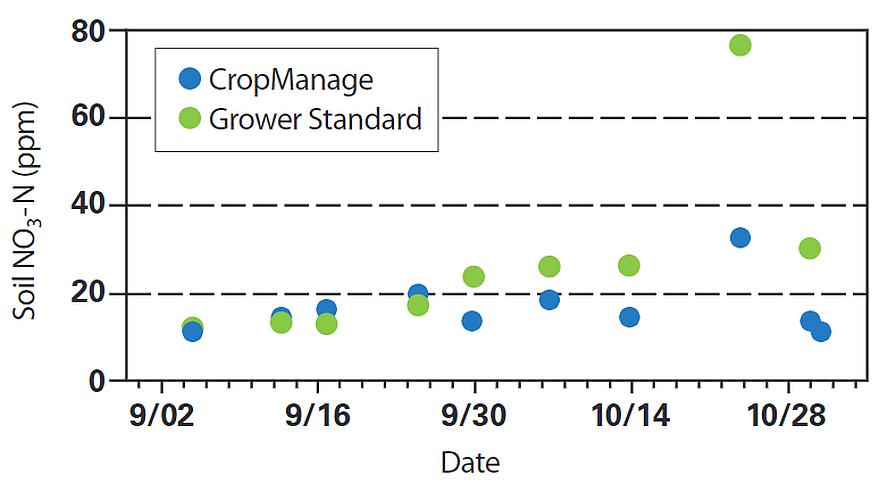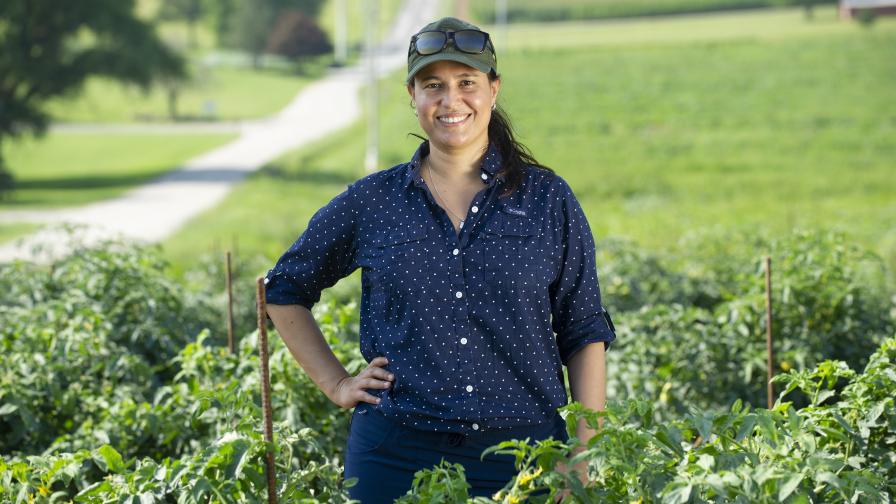Key Practices That Can Help Farmers Cope With Rising Fertilizer Costs
With fertilizer prices spiking, growers may be interested in a study we conducted in 2019. It illustrates two key practices that can help growers efficiently manage nitrogen applications and minimize over application that is now so costly.
Carefully monitor residual soil nitrates and account for them when deciding fertilizer application.
Calculate irrigation water applications to reduce nitrate loss.
The Study
Working with a cooperating grower to evaluate water and nitrogen management of romaine lettuce, we split the field in half. On one side, the CropManage decision support tool, CropManage.ucanr.edu, guided irrigation and fertilizer decisions. The other half of the field followed the grower’s standard practices.

The soil nitrate evaluations indicated that only moderate amounts of N were needed at each fertigation; in addition, adding one extra fertigation event in the CropManage treatments improved the ability to precisely manage what the crop needed. The high final fertilizer application on the grower treatment did not improve yields and resulted in more residual nitrogen in the soil at the end of the season.
Graphic by Richard Smith
The bottom line? We found careful irrigation scheduling and monitoring of soil nitrate helped reduce nitrogen fertilizer applications and safeguarded yields.
Irrigation Details
Romaine lettuce germinated using subsurface drip buried at a 3- to 4-inch depth in the center of 40-inch-wide beds. We installed flowmeters to monitor irrigation on both the CropManage and grower standard treatments.
We applied similar volumes of water in both treatments during germination and stand establishment (CropManage = 3.4 inches; grower standard = 3.7).
Detail Of the Field

After thinning until harvest, we applied different amounts of water to the two treatments. The ideal amount of water recommended by CropManage was 3.8 inches of water. CropManage bases the recommendation on reference evapotranspiration data (ET) from the nearest CIMIS (California Irrigation Management Information Systems) weather station, a crop coefficient model based on canopy development and considerations of the application uniformity of the irrigation system. In the grower standard practice, we applied 3.3 inches; in the CropManage treatment, we applied 3.8 inches.
Both management treatments applied close to the recommended amount of water to avoid leaching of nitrate during the production season.
Nitrogen Fertilizer
We applied 20 gallonsl/acre of 5-20-0 to both management practices at planting as an anticrustant/starter fertilizer. Then we monitored soil nitrate in the upper foot in both management zones at regular intervals during the season.
Soil nitrate levels were moderate at the thinning (less than 15 ppm NO3-N), and we added fertilizer to both systems.
The big difference between nitrogen management between the CropManage and grower standard treatments was in the mid-October fertilizer applications.
In the CropManage treatment, we made a more moderate application in early October because soil nitrate levels were still moderately high (18 ppm NO3-N). Later we applied a fourth application of nitrogen fertilizer through the drip system (39 pounds N/acre) to supply sufficient N to match crop uptake demand until harvest.
In contrast, the grower standard practice applied 91 pounds N/acre through the drip system as a third and final application in mid-October.
Total N applied to the CropManage treatment was 129 pounds N/acre, and 191 pounds N/acre to the grower standard treatment.
Harvest
Commercial yields evaluations were made in adjacent 12 bed-wide strips (by the length of the field). Carton yield (pounds/acre) was about 5% higher in the CropManage area, although cartons per acre were 3% higher in the grower management zone due to a higher final plant population. Disease pressure from INSV (Impatiens Necrotic Spot Virus) and Sclerotinia caused plant loss and affected the final plant populations in the management zones.
Net carton weight of the grower standard area averaged 2.4 pounds per box less than the CropManage area. And plant tissue had a lower water content than the CropManage treatment. The higher plant weight and water content measured in the CropManage area may be due to the extra water applied to this treatment during the final few weeks of the crop.
In contrast, the extra nitrogen (90 pounds/acre) applied to the grower management area did not increase plant weight and growth relative to the CropManage area.









